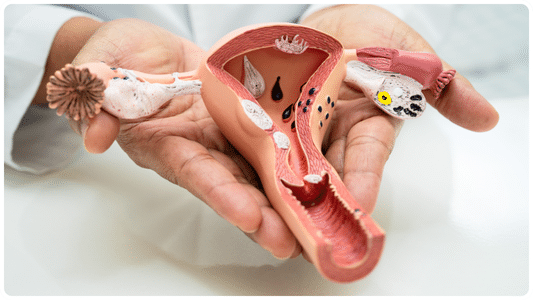
Featuring City Fertility Sydney CBD fertility specialist, A/Prof Michael Cooper OAM
How I Cured My Adenomyosis – A Myth or Reality?
April marks Adenomyosis Awareness Month, a time to highlight this often misunderstood condition that impacts many women and individuals assigned female at birth. While some claim to have “cured” adenomyosis, the reality is that there is no absolute cure, only effective management strategies. In some cases, women may also worry about adenomyosis cancer symptoms, as the condition can share similarities with certain uterine cancers, making accurate diagnosis crucial. In this blog, A/Prof Michael Cooper OAM will share his expertise and insights into adenomyosis. Understanding adenomyosis symptoms, diagnosis and treatment is crucial for improving the quality of life for those affected, as well as the impact on fertility.
What is Adenomyosis?
Adenomyosis occurs when tissue similar to the lining of the uterus, the endometrial tissue, grows into the muscular wall of the uterus. The displaced tissue continues to act normally — thickening, breaking down and bleeding — during each menstrual cycle. This infiltration can lead to various symptoms, including heavy menstrual bleeding, severe cramping, and an enlarged uterus. Understanding the underlying mechanisms of adenomyosis is essential for accurate diagnosis and effective management of this condition. It is most likely that the disorder relates to an as yet unidentified abnormality at the endo-myometrial interface (EMI) and, in this respect, is similar to endometriosis as it is known there are abnormalities in this area also.
Adenomyosis and Endometriosis – Understanding the Key Differences
Despite their shared characteristics, it’s essential to differentiate adenomyosis from endometriosis due to variations in their anatomical presentation and diagnostic methods. Endometriosis involves the presence of endometrial-like tissue outside the uterus, both within the pelvis and in extra pelvic regions, whereas adenomyosis specifically refers to the presence of this tissue within the muscular wall of the uterus. Understanding these differences is crucial for accurate diagnosis and treatment planning
| Adenomyosis | Endometriosis | |
|---|---|---|
| Location | Within the uterine wall or myometrium. | Outside the uterus. |
| Symptoms | |
|
| Diagnosis | Ultrasound or MRI. | Ultrasound, MRI or laparoscopy. |
| Effect on fertility | Controversial but probable. | Stage related decrease in fertility. |
| Treatment | Medical therapy with progestogens or Mirena, Ryeqo. | Pregnancy, medical therapy with progestogens, surgical excision. |
Adenomyosis Symptoms
Classically the disorder appears from the age of 35 into the 40’s, with the symptoms of adenomyosis varying widely in intensity. While some individuals may experience no symptoms at all, others may face debilitating challenges. Common symptoms include:
- Enlarged uterus which can create a lower belly bulge (often referred to as an adenomyosis belly)
- Heavy or prolonged menstrual bleeding
- Severe cramping or sharp, knifelike pelvic pain during menstruation (dysmenorrhea)
- Longer than normal menstrual cycles
- Pain during sex (dyspareunia)
- Abdominal tenderness
- Chronic pelvic pain, often a central, heavy, cramping pelvic pain that varies in intensity
- Referred leg pain
- Anaemia or iron deficiency (due to heavy periods), leaving you feeling tired or dizzy.
- Difficulty trying to conceive
What Causes Adenomyosis
Adenomyosis affects 1 in 5 women and individuals assigned female at birth, making it more common than endometriosis. We know it occurs when tissue similar to the lining of the uterus, grows into the muscular wall of the uterus, causing pain. While the exact cause remains unclear, adenomyosis only affects those who menstruate and is usually diagnosed in people over 30 years.
How is Adenomyosis Diagnosed
Unfortunately, diagnosing adenomyosis poses challenges, traditionally relying on an index of suspicion clinically followed by the finding of a painful (‘bulky’) uterus. Imaging techniques such as ultrasound may reveal irregular areas, most usually in the posterior aspect of the uterus, although it can at times be difficult to differentiate these from fibroids. Fibroids tend to be more discreet, whilst adenomyosis tends to be more generalised, although, at times, there can be isolated areas of adenomatous change within the uterus. More recently, MRI has been advanced as a preferred diagnostic option, although currently, within an Australian context, the cost of this has kept it out of mainstream usage.
How Does Adenomyosis Affect Fertility
While adenomyosis has not been directly linked as a cause of infertility, fertility concerns may accompany a diagnosis of adenomyosis, prompting individuals to explore how the condition may impact their reproductive health. In adenomyosis, the displaced endometrial tissue can create an inflammatory environment within the uterus, potentially hindering the implantation of a fertilised egg, and hormonal imbalances associated with adenomyosis may disrupt ovulation or egg quality 1,2. Please note, there is no reason not to proceed with IVF if you have adenomyosis and many patients are still successful.
While adenomyosis can pose challenges to conception and pregnancy, it’s essential to recognise that not every woman with the condition will experience fertility issues. By consulting with fertility specialists and understanding the potential implications of adenomyosis on fertility, individuals can make informed decisions regarding family planning and pursue available treatment options to optimise their chances of conception.
Adenomyosis Treatments
Treatment strategies for adenomyosis aim to alleviate symptoms and improve overall well-being. Treatment for adenomyosis depends on the severity of symptoms and the individual’s reproductive goals.
If you are trying to conceive, your treatment options may include simple pain relievers and non-steroidal anti-inflammatory drugs. For those in whom pregnancy is not a consideration it may be possible to use Mirena, the new progestegin impregnated IUCD (although this at times may exacerbate the situation) or alternatively the oral contraceptive pill to relax the uterus. There is a new contraceptive called Ryeqo which shows promise in managing adenomyosis. A hysterectomy is also an option.
Adenomyosis, though often overlooked, can significantly impact the lives of those affected. By raising awareness and understanding its symptoms, diagnosis, and treatment options, individuals can seek appropriate care and support. If you suspect you may have adenomyosis or are experiencing symptoms, consult with a healthcare professional for proper evaluation and management. Together, we can work towards improving the quality of life for those living with adenomyosis.
To book an appointment or learn more about A/Prof Michael Cooper OAM, visit his profile.
FAQs about Adenomyosis
How to get pregnancy with adenomyosis naturally?
Getting pregnant naturally with adenomyosis can be challenging, but it is possible. Adenomyosis is associated with hormonal imbalances, particularly excess estrogen, an irregular menstrual cycle affecting ovulation and embryo implantation issues. A fertility specialist can assess your hormones and ovulation. They can help balance your hormones with diet and lifestyle modifications and if required progesterone support to improve natural conception.
Does adenomyosis affect fertility?
Adenomyosis has not been directly linked as a cause of infertility. Despite this, some individuals with adenomyosis do struggle to conceive. The two most common fertility concerns relate to ovulation disorders and displaced endometrial tissue can create an inflammatory environment within the uterus, potentially hindering the implantation of a fertilised egg.
Can you have adenomyosis and endometriosis
Yes, it is possible to have both adenomyosis and endometriosis at the same time. Historically adenomyosis has tended to be a disorder diagnosed in a slightly older population although more recently younger patients are presenting with a diagnosis of adenomyosis on ultrasound. It is also quite common for patients initially to present with endometriosis, particularly those with the more severe form of the disease, who then years later develop adenomyosis.
_______________________________________________
1 Khan, K. N., Fujishita, A., & Mori, T. (2022). Pathogenesis of human adenomyosis: current understanding and its association with infertility. Journal of Clinical Medicine, 11(14), 4057.
2 Pados, G., Gordts, S., Sorrentino, F., Nisolle, M., Nappi, L., & Daniilidis, A. (2023). Adenomyosis and Infertility: A Literature Review. Medicina, 59(9), 1551.















